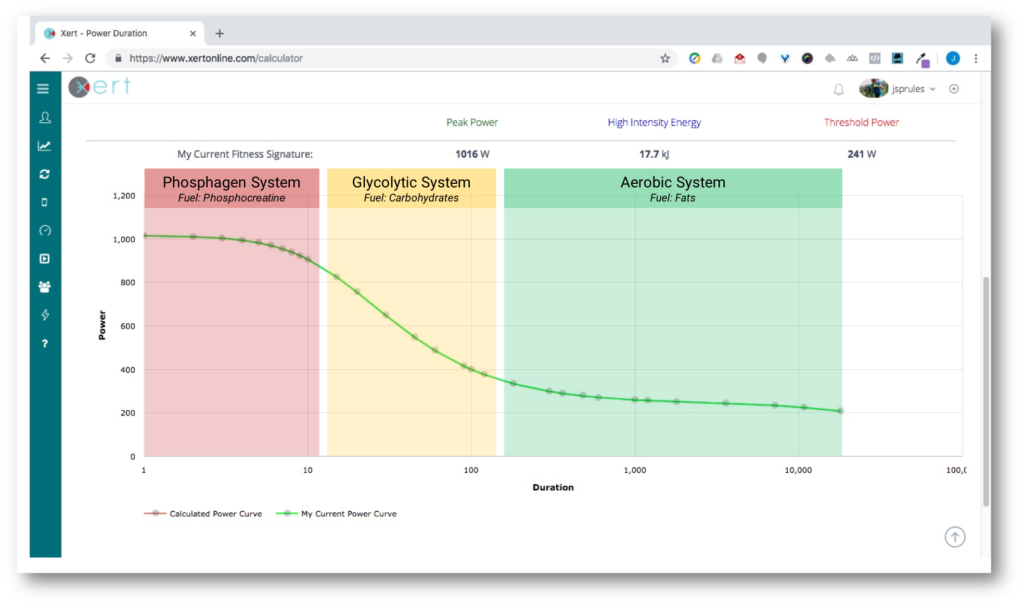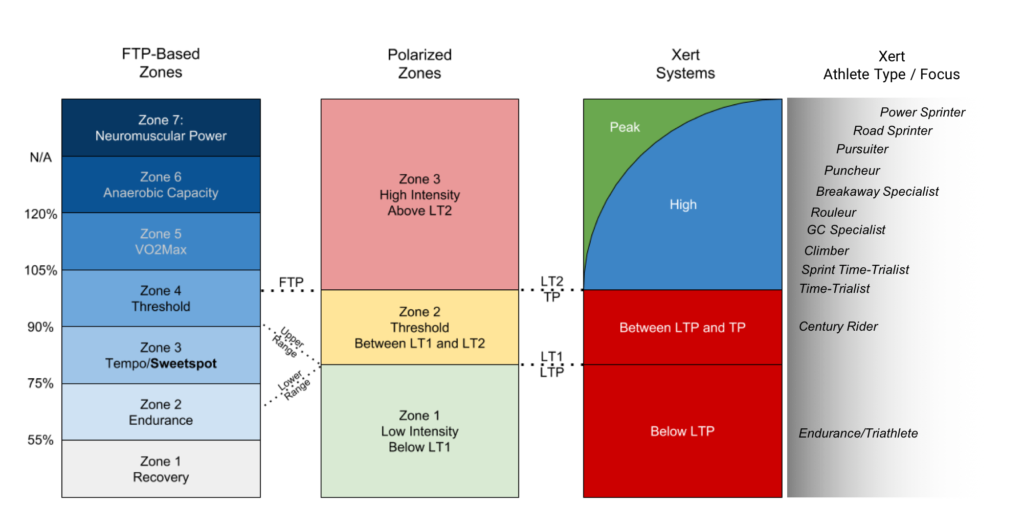Introduction
In this article, we will provide an overview of metabolic pathways and how these pathways affect your riding and racing. Through these metabolic pathways, the body converts stored chemical potential energy from food, into mechanical energy used to power our bikes or our runs. How this energy is converted is dependent upon exercise intensity, duration, and nutritional state. A greater understanding of these pathways will help you get more from Xert and further develop yourself as an athlete.
The Energy Systems
The “currency” of cellular energy is adenosine triphosphate (ATP). However, the cellular concentration of ATP is only enough to sustain a few contractions. To counter this, the body produces additional ATP through various metabolic pathways, depending on cellular conditions. The three main energy systems are aerobic oxidation, glycolysis, and phosphagen cleavage.

Figure 1. The relationship between power duration and metabolic pathways. It’s important to note that these energy systems do not work independent of one another, but rather work synergistically to respond to the stochastic demands of cycling.
When exercise intensity is low, energy can be derived through the oxidation of fats into carbon dioxide. Aerobic oxidation is highly efficient, but is rate-limited. The human body is able to aerobically oxidize fat very efficiently when blood lactate levels stay similar to resting values, correlating with intensities below LT1 – approximated in Xert as Lower Threshold Power (LTP). This aerobic system is capable of providing many hours of energy because the body contains a virtually unlimited supply of fats. As exercise intensity increases – above LTP, but below Threshold Power (TP) – the aerobic oxidation of fats cannot deliver energy at a sufficient rate to meet the demand, and the body begins to use glucose as a fuel source. As power output approaches Threshold Power, anaerobic glycolysis (the breakdown of glucose in the absence of oxygen) gradually increases, resulting in the production of lactate. Provided power output remains below TP, blood lactate concentrations remain constant because the rate of production is matched by the rate of clearance from the muscles.
Did you know? If you’re using Xert’s MPA & Colour-coded Power datafield for Garmin, intensities from below to just above LTP are shown with power in green, and intensities between LTP and TP are shown with power in blue. If you’re just above Threshold, the power is shown in white.
Once Threshold Power is reached, the body can no longer clear lactate quickly enough, resulting in the progressive accumulation of lactate. Continued anaerobic glycolysis provides rapid energy conversion for high intensity work, but at the cost of efficiency. This principle is modelled in Xert: as an athlete’s power nears their Maximal Power Available (MPA), the strain rate increases. In other words, the rate at which XSS is ‘earned’ per minute increases as power nears MPA. The result is rides and workouts with far more than 100XSS in an hour! Furthermore, since the body is limited to a finite store of approximately 500g of carbohydrate, carbohydrate supplementation (bars, gels, etc.) may be required during high-intensity training sessions or during prolonged endurance rides.
None of the aforementioned energy systems are able to generate ATP quickly enough to fuel short (<10 s), peak-intensity sprints. During these short, maximal efforts, ATP is replenished from the anaerobic breakdown of phosphocreatine (PCr). Muscle cells contain only enough PCr to power a short sprint, thus limiting an athlete’s top-end power. It’s important to note that replenishment of PCr can only be performed under aerobic conditions, and that the recovery is dependent on muscle oxidative capacity (think LTP here). Because of the nature of sprinting, sprints are often associated with peak strain, since work is being performed close to MPA.
As stated previously, it is important to highlight that although certain intensities elicit greater contributions from certain pathways, these systems do not work in isolation. Instead, all pathways work together in response to the dynamic energetic demands of cycling.
Nutritional Implications
We’ve seen how exercise intensity and duration affect the metabolic pathways, but what about nutritional state? Some athletes have taken to the idea of performing fasted workouts, intentionally depriving their body of carbohydrates. The idea is that the limited availability will provide superior adaptations in oxidation of fats, increasing the sustainable aerobic power output. On the other hand, several studies have shown the efficiency of “carbo-loading”, or a carbohydrate-rich diet in the days leading up to a big event. In carb-loading, the general idea is to supply (and subsequently store) excess glucose to the muscles. A more detailed discussion on this topic is beyond the scope of this post, but if you’d like to know more, at the end of this post is a list of peer-reviewed articles on the subject.

Figure 2. Relationship between 7 powers zones, polarized zones, and Xert’s measures of LTP and TP. In this figure, from the Xert article Sweet Spot, Threshold and Polarized Training … By the Numbers, notice the relationship between LT1 and Lower Threshold Power, and between LT2 and Threshold Power.
Summary
In this post we covered the main metabolic pathways that fuel your rides. Low intensity exercise results in aerobic oxidation of fats, while high intensity efforts are anaerobically supplied by glycolysis and the breakdown of phosphocreatine. We also discussed how nutritional status can also influence metabolic preference. I hope you found this information helpful, and if you did – please share it with a friend! Be sure to follow along, as I will expand upon this foundation in an upcoming article where I will discuss how to utilize the power of Xert to focus your training on these pathways and make you fitter and faster than ever.
To learn more about the ideas presented in this article, please feel free to review some of these resources:
Sedlock, DA. The latest on carbohydrate loading: a practical approach. Curr Sports Med Rep. 2008;7(4):209-13.
Van Proeyen K, Szlufcik K, Nielens H, Ramaekers M, Hespel P. Beneficial metabolic adaptations due to endurance exercise training in the fasted state. J Appl Physiol (1985). 2010;110(1):236-45.
Vanhatalo A, Black MI, DiMenna FJ, et al. The mechanistic bases of the power–time relationship: muscle metabolic responses and relationships to muscle fibre type. J Physiol. 2016;594(15):4407–23.




